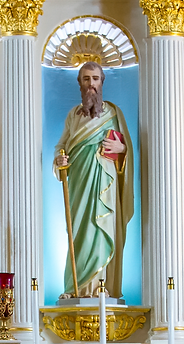About Divine Mercy Parish
PATRON SAINTS OF OUR CHURCH


St. Peter (Św. Piotr) - patron saint of fishermen, net makers, and ship builders
(died ca. 65 A.D.) the head of Jesus' 12 Apostles and the first Pope (Bishop of Rome and Vicar of Christ). Peter met Jesus while they were listening to a sermon by St. John the Baptist. From the moment Peter met Jesus, he knew he was the Messiah. Likewise, from the moment Jesus met Peter, he knew he would be the rock of the Church. "Tu es Petrus..."
Matthew 16:18-19: "And I say to thee: That thou art Peter; and upon this rock I will build my church, and the gates of hell shall not prevail against it. And I will give to thee the keys of the kingdom of heaven. And whatsoever thou shalt bind upon earth, it shall be bound also in heaven: and whatsoever thou shalt loose upon earth, it shall be loosed also in heaven."
St. Peter was the first person Jesus visited after the Resurrection. It was there that Jesus confirmed he would be the leader of the Church. As such, Peter went on to be the first in an unbroken succession of Popes in the Catholic Church. Like Jesus, he died a martyr. Much can be learned about St. Peter in the New Testament, particularly within the four synoptic Gospels.
St. Paul (Św. Paweł) - patron saint of missions, theologians, and gentile Christians
(died ca. 64-67 A.D.) one of the most important and influential of all the saints. Many of his writings are contained in the Canon of the Bible and have influenced the growth and development of the Church since the first century.
St. Paul was originally known as Saul, and he was a Roman citizen and a Pharisee. He even presided over the persecutions of the early Christians and was present at the martyrdom of St. Stephen. However, Saul experienced a powerful vision that caused him to convert to Christianity while on the road to Damascus. He was duly baptized and took the name Paul.
Paul traveled the world, first to Arabia then back to Damascus. He also visited Jerusalem to see St. Peter, the first pope and pay homage to him. During these travels, he preached ceaselessly, often drawing criticism and ire from those who rebuffed his message. Jews, in particular, hated his preaching as they saw him convert people to Christianity from Judaism.
Eventually, Paul returned to Tarsus, where he was born. He preached there until he was called by Barnabus to come to Antioch. After a year spent in Antioch, a famine occurred in Jerusalem and the pair was dispatched to the city with alms. Paul and Barnabus then went forth on a mission to Cypress and throughout Asia Minor. They established several churches in their travels. After establishing his churches, Paul remained in communication with the faithful, often writing letters to answer questions and resolve disputes.
The letters that have survived have become part of the Bible. It is believed that Paul wrote other letters, which were lost even before the Bible was established by the Church. Paul's writings are important because they provide good advice for how Christians should live.
Paul traveled throughout much of Europe, particularly in Macedonia, Greece, and Italy. While preparing for a missionary trip to Spain, he was imprisoned in Caesarea by the Jews for two years. He traveled again, was shipwrecked in Malta, and was imprisoned for another two years for preaching in Rome. Despite these imprisonments, Paul continued to preach.
Paul eventually made his way to Spain, then returned to the East, and finally returned to Rome once again. In 67 AD, Paul was arrested in Rome for a second time and this time he was beheaded under the insane Emperor Nero. According to John Chrysostom, Nero knew Paul personally.
FEAST DAY OF STS. PETER AND PAUL: June 29th
